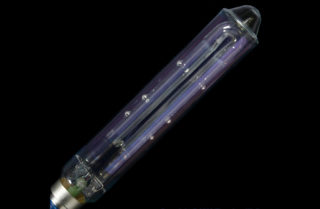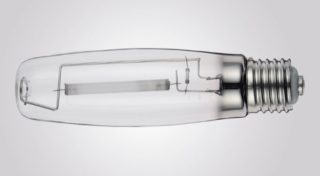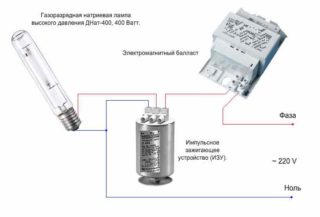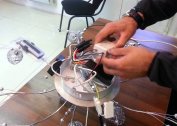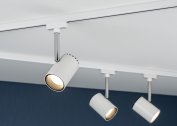A few decades ago, sodium lamps were the most popular due to the lack of worthy analogues. They were almost universally used to illuminate streets and roads. Somewhat less often they began to be used with the advent of LED bulbs, but at the same time they are not going to give up their positions completely.
What is a DNA lamp and its varieties
Lighting fixtures DNaT is one of the types of high pressure sodium bulbs. The abbreviation DNaT stands for "Arc Sodium Tubular." Devices of this type are divided into several varieties - DNaS, DNaZ and DNaMT. Each of them has its own individual characteristics, advantages and disadvantages.
- DNaS is a light-scattering lighting devices. A special pigment is used as a diffuser, which processes the entire inner surface of the outer bulb. The spectrum of this type of light bulb resembles a daylight.
- DNAZ - the glow of the burner has a certain focus. The device is characterized by special spraying with a reflector on the external flask of the device.
- DNAMT - equipped with a frosted flask. This variety is an analogue of DNaS, which today is already out of production. They are used to replace DRL lighting devices without affecting the quality of lighting.
All sodium lighting devices are divided into two types, depending on the principle of operation - low and high pressure lamps.
Low pressure sodium lamp
Low-pressure lighting devices have several specific features. For example, in the manufacture not ordinary glass flask is used, but high-strength borosilicate glass. This is a necessary measure, since the effect of sodium vapor on glass surfaces is aggressive and destructive.
In short, this variety is called NLND, its effectiveness depends primarily on the ambient temperature. To ensure optimal conditions for uninterrupted and long-term operation, the bulb is additionally placed in a glass outer flask, which not only protects the structure from aggressive environmental factors, but also serves as an unusual thermos.
High Pressure Sodium Lamps
Compared with the previous version, high-pressure sodium lamps have several significant advantages - phenomenal efficiency and high-quality color reproduction. With a power of 30 to 1000 W, light output reaches 160 lm / W; the operational life, as a rule, is about 25,000 hours.
Due to its high brightness and compact size, the field of application of high pressure modules is wide.
Such varieties of sodium lamps are used necessarily with electronic or inductive type ballast. Ignition occurs using a special electrical device - IZU, which guarantees an uninterrupted supply of pulses up to 6 kW.
As a rule, no more than 5 minutes pass from the moment the high-pressure sodium lamp is started until the full-fledged lighting appears.
Design features of DNaT lamps and principle of operation
The principle of operation of a sodium discharge lamp is based on the chemical properties of sodium vapor, which under certain conditions can emit bright monochromatic bright light.The gaseous medium is placed in a special tube, which is called the burner. Heated sodium vapor has a destructive effect on glass surfaces, therefore, high-quality borosilicate glass or polycrystalline aluminum oxide is used in the production.
Each side of the burner is equipped with electrodes, the task of which is to create arc discharges that heat sodium vapor. The whole structure is placed in a sealed glass flask, which ends with a threaded base of various types.
The sodium lamp burner is ignited by an electric arc, which is formed due to the electrodes. As a result, a large number of charged particles are formed in the channel. For a better glow, the flask contains not only sodium vapor, but also mercury, xenon or argon. Today mercury-free lighting has been developed, but their design features are extremely complex.
Ignition of lighting devices occurs at a time when a high pulse voltage is applied to the cathodes. For no more than 5 minutes, the lamp may dim, then it will reach the optimum operating temperature.
You can’t just throw out sodium lamps. Failed devices must be taken to special collection points. If the flask is recycled with glass, all of the smelting will be damaged due to the content of aluminum oxide and quartz in the composition.
Wiring Diagrams
For the first start-up of a sodium lamp, it is not enough just to apply a supply voltage to it; for this, special pulse ignition devices of the IZU type are used once. This is due to the fact that a cold burner has a high resistance, as a result of which it simply does not start.
After the first start-up, the current flow through the lamp must be limited. For this, an electronic or electromagnetic ballast is created.
IZU is connected in parallel, the throttle is switched in series with the bulb. IZU are divided into two types: three-pin and two-pin. The cost of the latter is lower and it is easier to connect, the former more correctly performs the tasks assigned to it.
It is important to install DnaT lamps using clean cloth or cotton gloves, as the temperature of the instrument bulb reaches 300 degrees Celsius. If you touch the flask with greasy fingers, a carbon layer will form that does not conduct heat well.
Technical comparison with analogues
To understand why sodium lamps are still used, it is recommended to compare their technical characteristics with the features of analogues.
| Type of lighting lamp | The duration of the operational period, h | The created light stream, lm | Nameplate power of a product, W |
| DNAT-100 | 6 000 | 9 400 | 100 |
| DNAT-150 | 10 000 | 14 000 | 150 |
| DNAT-250 | 15 000 | 24 000 | 250 |
| DNAT-400 | 15 000 | 47 500 | 400 |
| DRL-125 | 12 000 | 6 000 | 125 |
| DRL-250 | 12 000 | 13 000 | 250 |
| DRL-400 | 15 000 | 24 000 | 400 |
| LED analog of DRL-125 | 10 000 | 2 500 | 40 |
| LED analog of DRL-250 | 10 000 | 5 000 | 80 |
Scope of application

Modules of sodium vapor due to poor color accuracy are not intended for use in everyday life, most often they are installed to illuminate the street and household plots, as well as avenues and highways.
DNAT lamps are installed in electrical equipment designed for backlighting and background lighting:
- In greenhouses, conservatories and greenhouses to ensure the basic yield of cultivated plants, as well as to increase their growth rate.
- Container sites, sports facilities and tunnels.
- Warehouse and industrial premises, workshops, where the color rendering quality does not play a big role.
- Architectural buildings and historical monuments.
- Airports, train stations, etc.
In all of the above cases, sodium lamps provide adequate illumination with minimal energy consumption.
Advantages and disadvantages
- Minimum power consumption, profitability.
- Good light output.
- Operating temperature ranges from -60 to +40 degrees Celsius.
- The presence of thermal radiation.
- High efficiency.
- Long service life.
- The luminous flux does not change even after a while.
Among the shortcomings can be identified:
- Ignition of the device and stabilization of the glow takes 5-7 minutes.
- The color range at the end of the operating period may vary.
- At abnormally low temperatures, the luminosity decreases.
- Lamps containing mercury cannot be classified as safe.
It is recommended to purchase DNaT lamps and its analogues in specialized stores where accompanying documentation and a warranty card are attached.

